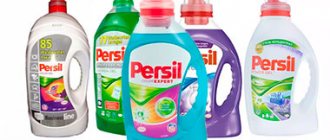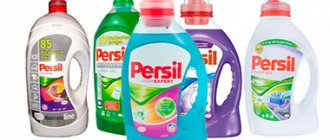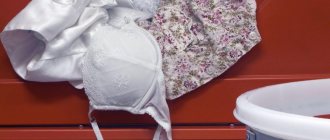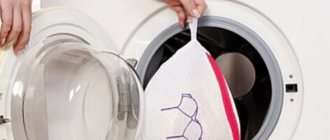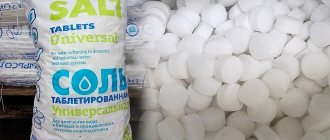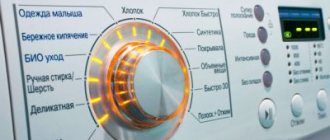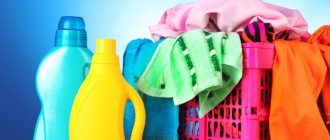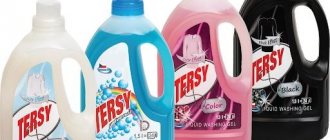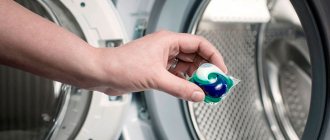Antibacterial laundry detergent is used both in specialized medical institutions and at home. The professional use of disinfectants is regulated by special instructions and is strictly controlled. In everyday life, a person encounters various viruses and microbes every second; the situation becomes more complicated if there are children, animals or sick people in the family. Doctors do not recommend using antibacterial soap for everyday use - it disrupts the natural biobalance of the skin, but is this true for clothing and household items?
Why do you need antibacterial washing?
There are a huge number of diseases that require mandatory disinfection and quarantine, even if the patient is at home. Caring for bedridden people requires disinfecting bedding and clothing to avoid irritation, infectious wounds and bedsores. People with weakened immune systems, after a course of chemotherapy and immunosuppressants, are at risk; any bacteria can worsen the condition. Timely disinfection of beds, rugs, and pillows will not interfere with animal owners and will protect them from infection with helminths. It is better to consult a pediatrician about how to disinfect children's things to avoid allergies.
Our works
October 15, 2019
Maintenance of septic tank Tver in Mytishchi
Moscow region Urban district Mytishchi village.
Malaya Ivanovskaya October 4, 2019
Maintenance and cleaning of septic tank Tver
Moscow region Odintsovo district village.
Podlipki July 17, 2019
Maintenance of septic tank Tver 2P
Moscow region Mytishchi urban district, village.
Zhostovo September 18, 2018
Repair of external septic tank hood
External hood repair in Pushkinsky district
How does laundry detergent kill bacteria?
Disinfection methods can be chemical or physical. Boiling, calcination, steaming, exposure to ultraviolet radiation are classified as physical, while acids, alkalis, formaldehydes, and halogens are classified as chemical. The oldest method of treating laundry was boiling with lye. It is still used today, although the powders and antibacterial gels available in large quantities can satisfy even the most demanding buyer.
One of the important criteria for assessing the effectiveness of the product is the test for the destruction of Mycobacterium Terra. This new strain is extremely resistant to chemical agents; it is believed that the death of this mycobacterium also means the death of any other microorganisms, including Mycobacterium tuberculosis.
Antibacterial powder, in addition to surfactants and ballast substances, contains an antiseptic agent, for example, chlorine, active oxygen, didecyldimethylammonium chloride, polyhexamethylene biguanide hydrochloride. The chemical damages the cytoplasmic membrane and destroys the viral or bacterial cell.
It is worth saying that the use of powders based on acids and chlorine spoils clothes, the fabric becomes thinner and loses color. Washing at a temperature of 60–90 degrees in a washing machine can easily cope with the usual microbes and dust mites, but scientists say that pathogenic bacteria do not die at a temperature of 40 degrees, but only move from fabric to fabric. Therefore, if the maximum permissible temperature on a clothing label is 30 degrees, then it’s time to think about antibacterial household chemicals.
Detergent compartment
With each wash, the tray for powder and conditioner becomes covered with a coating of mineral salts present in hard tap water and residues of liquid and powder detergents. It is difficult to wash the tray in a washing machine, so you need to remove it and soak it for 1-2 hours in soapy water, but better in a concentrated solution of Domestos or a similar disinfectant. When all deposits and growths have left the plastic, the tray can be rinsed with running water, and the most difficult areas can be rubbed with an unnecessary hard-bristled toothbrush. The hole under the tray must be cleaned, because there are also particles of dirt, water and detergents there, which will become a breeding ground for microbes.
Professional chemistry for disinfecting linen
When disinfection is necessary for medical reasons, you should not trust beautiful packaging, but it is better to turn to proven products with a certificate of conformity.
Multidez "Teflex"
The product is used to disinfect both surfaces and things. The composition includes surfactants and polyhexamethylene guanidine hydrochloride. The solution does not cause discoloration of fabric and corrosion of metals, and is not aggressive towards surfaces. In an undiluted state, it kills 100% of bacteria in 5 minutes, including influenza viruses, herpes, polio, hepatitis, and is also active against pathogenic fungi, gram-negative and gram-positive bacteria. Used for processing dishes, linen, appliances, shoes, indoor surfaces, toys in kindergartens, laboratories, markets, hairdressers, catering establishments and in everyday life. The washing time should be at least 30 minutes.
"Clovin II Septon"
Laundry powder contains sodium perborate tetrahydrate and tetraacytylamine, it is effective against candida and trichophytosis fungi, viruses. "Klovin Septon" operates on the basis of active oxygen, both in soft and hard water, but the temperature should not be lower than 65 degrees, and the washing time should not be less than 20 minutes. It is used in everyday life, at sports facilities, in public catering establishments, kindergartens, and schools.
"Glavstirka"
The powder contains 80% urea peroxyhydrate, and the mass fraction of active oxygen is at least 6.5%. Tested for activity against mycobacterium Terra, plague, cholera, tularemia, as well as influenza viruses, parenteral hepatitis, pneumonia, and some fungi. “Glavstirka” whitens well and removes stains. Suitable for most fabrics except wool and silk. The temperature and amount of powder must be accurately dosed according to the instructions. When machine washing, the dosage is calculated depending on the amount of water in the tank with a full load at the beginning of the cycle. This information can be found in the manual for the washing machine. In special cases, pre-soaking is required. When working with powder, you should wear gloves, goggles, and a mask. The container with the solution must be closed; pour the product carefully, without dust.
The chemical industry produces a large number of disinfectants, almost all of them are universal and suitable for both washing clothes and processing items. New drugs include Desam Extra, Baktol, Anavidin-Complete, Amixidin, ActiveBioProtect and others.
Causes of mold in the washing machine
There are many reasons why a washing machine becomes infected with mold. But almost always the owners of the unit are to blame for the increased proliferation of fungus because they do not follow the rules for caring for household appliances.
As mentioned above, mold can grow and multiply rapidly only in appropriate conditions. Ideally, this is 90% humidity and 20 °C temperature. Small deviations from these indicators are also quite acceptable for microscopic fungi.
In the bathroom, the washing machine will always be in a damp, warm atmosphere. If possible, it is better to immediately install the machine in another, drier room
In a person’s home, such conditions are maintained in the bathroom all year round, so installing a washing machine here is extremely undesirable.
For this purpose, a kitchen or hallway is more suitable. If there is no choice and installation is possible only in the bathroom, you should definitely take care of good ventilation.
Moisture remains on the cuff, inside the tank and on other parts of the unit at the end of the washing process of the loaded laundry. She needs to be given time to evaporate, leaving the door open for these purposes.
As a result, drops of water remaining inside the machine after washing create excellent conditions for the life of mold fungi.
At the end of the wash, a certain amount of water almost always remains in the folds of the rubber cuff, which acts as a seal for the door. Gradually it will evaporate, which is guaranteed to provide high humidity inside the machine. This is exactly what mold spores need to grow rapidly.
In order to save energy, owners constantly wash in low-heated water. This is fraught with the fact that the components of the washing machine are not disinfected at high temperatures.
Using programs with modes of 60 °C and above causes the development of fungi to stop and their death. Lower temperatures only promote their development
However, it is not at all necessary to constantly use these detergents. Alternating through 3-4 washes with regular powder is enough.
With modern detergents containing bleach, it is not necessary to wash only pure white laundry. Some colored items will not fade when washed using the above powder.
Another possible cause is improper washing with fabric softener. When washing with conditioner, be sure to run an extra rinse.
If this is not done, again for reasons of economy or simply due to ignorance, particles of rinse aid remain on the door, in the folds of the rubber cuff, on the drum mesh and the walls of the tank. This breeding ground is perfect for mold growth.
Mold in the washing unit can be caused by improper connection to the sewer system. As a result, the water does not drain correctly and some of it remains inside the machine.
Stagnant, dirty water is the best way to promote the development of mold colonies.
To correctly connect the washing machine to the sewerage system, it is advisable to use the manufacturer’s recommendations for self-installation or invite a specialist
Review of powders with antibacterial effect for daily use
For lovers of dazzling cleanliness, it will be useful to know that you can take care of your health without gloves and safety glasses. Some brands have introduced antibacterial household chemicals to the market that are easier to use.
Burti Hygiene, Germany
“Burti” does not contain chlorine, whitens well, removes stains, prevents the growth of bacteria without boiling, etc. Can be used for children's underwear, tested according to German standards, approved by the Robert Koch Institute. The composition includes less than 5% nonionic surfactants, polycarboxylates, 5–15% anionic surfactants, soap, zeolites, oxygen bleach, enzymes, fragrance, optical brightener, disinfectant. The manufacturer did not say which disinfectant, but the packaging says that it destroys 99.99% of bacteria, viruses, and fungi.
LION Top Hygia, Japan
The new generation gel does not contain phosphates and aggressive surfactants. The main substance contains methyl ether ethoxylate - our own invention, which dissolves sebum in a special way, microscopic positively charged particles prevent the growth of bacteria on protein stains, as well as tea tree oil, which allows you to keep your laundry fresh after washing. The manufacturer updated the composition in 2022 and added a component that kills gram-negative bacteria.
"White"
A widely known bleach and disinfectant contains sodium hypochloride and is a strong oxidizing agent. Available in the form of a liquid or gel, it has a pronounced smell of chlorine, is volatile, and is dangerous for the respiratory tract and mucous membranes. Use only for cotton and linen fabrics; synthetics and colored items cannot be processed. Works well in both hot and cold water. It has a limited shelf life: a 9% solution at a temperature of 25 degrees decomposes after 240 days. It spoils and discolors the fabric. Contrary to popular belief, sodium hypochloride is not a skin allergen, mutagen or carcinogen, which has been confirmed by toxicological studies. After household use, it decomposes into oxygen, water and ordinary table salt.
NS FaFa for children's underwear, Japan
The gel perfectly washes things, deeply conditions, and has a pleasant aroma of a blooming apple tree. Does not contain optical brighteners, very economical, contains antibacterial components. For 6 kg of laundry you will need 55 g of gel; the manufacturer advises rinsing clothes at least 2 times.
conclusions
- It is necessary to distinguish powders for household use with an antibacterial effect from products that are guaranteed to destroy all known pathogenic bacteria and viruses.
- When washing with strong disinfectant solutions, you need to remember safety precautions: do not inhale the vapors, work with gloves and a mask, if it gets on the mucous membrane, rinse thoroughly with clean cold water, consult a doctor.
- If you need to wash clothes of a patient with an infectious disease, do not trust powders for daily use with a disinfecting effect, despite the promises on the packaging. The effectiveness can only be confirmed by a certificate of conformity obtained after a series of tests, which could not be found for conventional powders.
- For complete disinfection, it is important to follow the instructions, not to violate the temperature regime and exposure time (the time spent in the solution until the bacteria are completely killed).
- If there are no medical indications, then special powders for disinfecting linen are not so necessary: fans of sterility get sick no less, the immune system needs constant contact with microbes.
- It is not possible in practice to find out whether the powder disinfects clothes; even strong chemicals can only cope under certain conditions. It is right to wonder why hospitals do not use new-fangled gels if the packaging claims 99.99% of killed viruses and microbes.
Ecolabel
To make it easier for customers to navigate, eco-labels have been developed - special signs that help identify products as environmentally friendly and safe. In each country, products are marked with their own marks. Pay attention to the signs confirming the environmental safety of products:
- “Leaf of Life” (Russia)
- "EU Flower"
- "Blue Angel" (Germany)
- "Northern Swan" (Scandinavia)
- Green Seal (USA)
- "Environmental Choice" (Canada)
